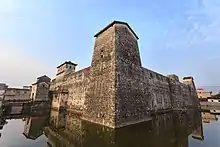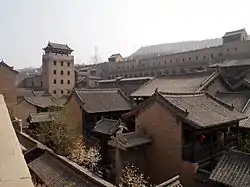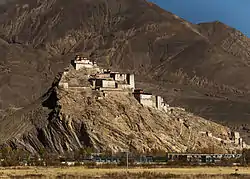
This is a list of castles in China. As feudalism in China had been largely superseded by centralised nation states since the Qin Dynasty from 221 BC, most Chinese castles were not intended as residences of the nobility, but are more properly described as either fortresses or fortified vernacular and religious structures. These can include fortified communal residences, private fortified residences of large landowning families, military purposed fortresses, and fortified religious architecture, especially in Tibetan regions (Dzongs). As such, the list can be broadly classified into these few categories.
True feudal castle
Surviving true feudal castles are built by Tusi, the hereditary leaders of self-governing ethnic minorities groups in Southwestern China during the Ming dynasty. Most Tusi rules are abolished by mid Qing dynasty. Three Tusi Sites were recognized by the UNESCO as World Heritage Sites in 2015.[1]
- Hailongtun Castle (海龙屯)
- Laosicheng (老司城)
Fortified communal residences or villages
In southern China, especially Fujian and Guangdong province, a type of fortified communal residence built by the Hakka people known as Hakka walled village (围龙屋/围楼) can be found. These are large multi-family communal living structure that were built by the immigrant Hakkas for protection in the event of clan wars with other Chinese clan groups (for example, see Punti–Hakka Clan Wars).

Some examples of Hakka walled villages are:
- Shuangfengzhai (zh:双峰寨)
- Mantangwei (zh:满堂围)
- Linzhai Sijiaolou (林寨四角楼)[2]
- Huilonglou (会龙楼)
- Bajiaowei (仙坑八角楼)
In northern China, especially Shanxi province, fortified villages also exist.
- Xiangyu village (湘峪古堡)[3]
Fortified private residences
Fortified private residences built by wealthy landowning families can be found throughout China. Generally built to protect from threats of bandits or periods of civil unrests.

Some examples in northern China are:
- Wang Family Compound (王家大院)
- House of the Huangcheng Chancellor (皇城相府)
In Fujian province, a unique type of fortified dwelling called Tu Bao (土堡) [4] can be found, and are built with a similar technique as Japanese castles with dry stone base supporting rammed earth and wooden structure above.
In Kaiping, Guandong province, multi-story fortified watchtower homes were built from the time of the Ming Dynasty to the early 20th century.
- Kaiping Diaolou (开平碉楼)
Military fortress
Fortified military fortresses are found at strategic locations such as mountain passes, along the great wall or part of the city walls of large towns and cities.
.jpg.webp)
- Shanhaiguan Castle (山海关)
- Juyongguan Castle (居庸关)
- Jiayuguan Castle (嘉峪关)
- Diaoyu Fortress (钓鱼城)
- Beijing city fortifications
- Qilu Fortress (zh:崎碌炮台)[7]
Tibetan Dzongs
Dzongs are a distinctive type of fortified monastery found in Tibetan areas such as Tibet Autonomous Region itself as well as parts of neighboring Qinghai and Sichuan provinces.


- Potala Palace (པོ་ཏ་ལ་ཕོ་བྲང 布达拉宫)
- Gyantse Castle (རྒྱལ་རྩེ་རྫོང་། 江孜古堡)
- Kampa Castle (གམ་པ་རྫོང 岗巴古堡)
Western-styled fortified architecture
As a result of contacts with the West and Christian missionaries from the 17th century onwards, western-styled fortified architecture, mainly Christian religious structures were also built.
- Our Lady of the Rosary Church in Daqi village, Zezhou County (zh:大箕玫瑰圣母堂)
- Monte da Guia Castle
See also
- List of castles
- Category:Forts in China
References
- ↑ UNESCO. "Tusi Sites". Retrieved 3 March 2023.
- ↑ 大地的细节 (18 Sep 2020). "探秘带着枪孔的城堡:林寨四角楼" (in Chinese). Retrieved 3 March 2023.
- ↑ Xinhua (31 Oct 2019). "Castle-like village in north China attracts many tourists". Retrieved 3 March 2023.
- ↑ Huang Shaojian 黄绍坚 (Nov 2020). "福建两"土"宝 比土楼防御更牛的是土堡". Chinese National Geography (in Chinese). Retrieved 3 March 2023.
- ↑ Lu Fanjing 卢范经 (28 Dec 2015). "大型夯土古民居——福建永安安贞堡". People's Daily (in Chinese). Retrieved 3 March 2023.
- ↑ Lin Shanchuan 林善传 (31 Dec 2019). "山里遗珠——大田琵琶堡". Chinese National Geography (in Chinese). Retrieved 3 March 2023.
- ↑ 骑在牛背上 (20 Jun 2021). "500米高空航拍汕头圆形城堡建筑,100多年历史,是当地标志性建筑". Chinese National Geography (in Chinese). Retrieved 3 March 2023.

